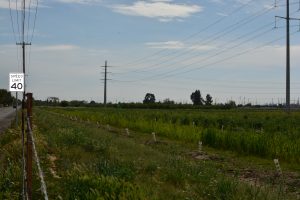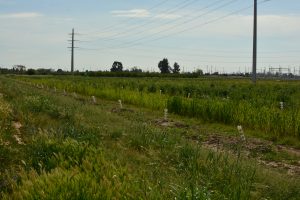
During the first week of March this year, laborers planted almond trees in the right of way of the future 132 Freeway/Expressway near Morse and Kansas Avenues. The new trees are almost completely hidden by tall weeds.
Caltrans announced in January 2017 that the new road would be completed by 2020. The almond trees will have to be removed first—after Caltrans pays top dollar for them. Meanwhile, Caltrans says it doesn’t have money to complete much infrastructure in the first phase of the freeway project.
Caltrans has not acquired all of the property needed to build the future freeway/expressway. Property owners often improve their property in advance of Caltrans purchases so that they can realize greater profits when they are “forced” to sell. Within the past 15 years, this has occurred at least twice for the Route 132 project; the same practice has occurred often throughout the state.
When Caltrans buys the property, the agency will have to pay for a developed orchard rather than vacant land. The new orchard will greatly increase costs of the property; a developed almond orchard may be worth double or more than a vacant lot. (Even if Caltrans owned the land and was leasing it, the lessee would still have to be reimbursed for the value of the orchard.)
Other orchards were planted in the right of way west of the newest orchard. The earlier orchards were planted so long ago that the trees are now in full production, making the orchards worth even more! Perhaps the latest orchard was planted under the assumption that the freeway would never get built. However, such an assumption is dubious given that Caltrans proclaimed in January 2017 that the project would be completed in 2020.
Another property enhancement occurred about 14 years ago, when the Needham Avenue Bridge was completed over the old Southern Pacific (now Union Pacific) railway. New buildings and businesses suddenly popped up at the intersection of Franklin and Needham Avenues, just west of the bridge.
Motorists are presently forced to turn right at the intersection; the buildings were constructed in the line of the future freeway/expressway. When the new road is built, Caltrans will need to pay for the land, the buildings, and the cost to remove the buildings.
Caltrans will have also have to pay the cost to relocate the businesses within the buildings; another expense will be the cost to the business for lost customers as a consequence of being moved. Had Caltrans acquired the property when the project was originally proposed 50 years ago, only inexpensive vacant land would have been purchased. The extra costs will be in the tens of millions of dollars if the project is ever built out.
Another unexpected problem popped up for the project. Since the 1960’s, Caltrans has changed its requirements for how a freeway is to be built. Due to “higher standards for freeway construction,” (arbitrarily established by Caltrans), additional right of way will be needed within Modesto city limits. More land and buildings will be purchased and more businesses will be paid to relocate. A number of displacement activities will occur around Kansas Avenue and Freeway 99. The price tag is unknown, but it will be substantial.
Insufficient Funds
For phase one of the project, Caltrans will not have sufficient funds to build a flyover connector ramp from Northbound Freeway 99 to Westbound Route 132. The ramp would be a major traffic carrier and is essential for a smooth transition from Freeway 99 to Route 132. In fact, the ramp is the first part of the project a reasonable person would expect to be built!

As a result of the lack of sufficient funds, a congested signalized intersection will be substituted for the flyover ramp; the intersection will be at the future junction of Needham Avenue/Franklin Avenue/132 Expressway. Expect the intersection to be a major source of traffic congestion immediately upon completion.
Ironically, if Caltrans didn’t have to pay inflated costs for the right of way, sufficient funds would be available to build the flyover. Caltrans will be paying inflated property values because the agency didn’t have the foresight to acquire all the property it would need when the freeway was planned 50 years ago. Land in 1967 was relatively inexpensive and mostly undeveloped within the planned right of way.
Caltrans also won’t have any money to remove the toxic waste dump currently located in the 132 Right of Way just east of Emerald Avenue; the dump will receive a cheaper alternative, a concrete cap that will eventually crack and become useless in protecting nearby residences.
Top Dollar
Paying top dollar has become the normal way Caltrans does business. Landowners are unjustly enriched because the agency doesn’t plan far enough ahead and acquire property during economic downturns or other opportune times. Instead, the agency gives landowners years of advance notice of a future road project, enabling sellers to improve their properties and enhance values during the interim; when Caltrans is finally ready to buy property, the owners receive windfall profits at taxpayer expense.
A classic example of Caltrans extravagance was the Century Freeway project in Los Angeles County, which connects Los Angeles International Airport to the Harbor Freeway. By the time Caltrans finished construction of the Century Freeway, ONE BILLION DOLLARS per mile of roadway was spent. In the 1960s, Caltrans could deliver freeway projects for a few million dollars per mile.
Without any incentive to deliver cost effective projects, construction simply stops when the money runs out. This is how the 132 project will be built. At the end of construction of the first phase of the 132 Freeway/Expressway Project, Modesto will have a mediocre, congested two lane expressway running from downtown a few miles to the west, ending when the money runs out. The drive will be as miserable or worse than the current route and no more safe.
Imagine how many more road projects could have been delivered if Caltrans and the state legislature had planned further ahead and established a better way to acquire land for new roadways.
Think about these costs the next time you see the sign that reads, “Your Highway Dollars at Work.” The dollars really aren’t working that well.
